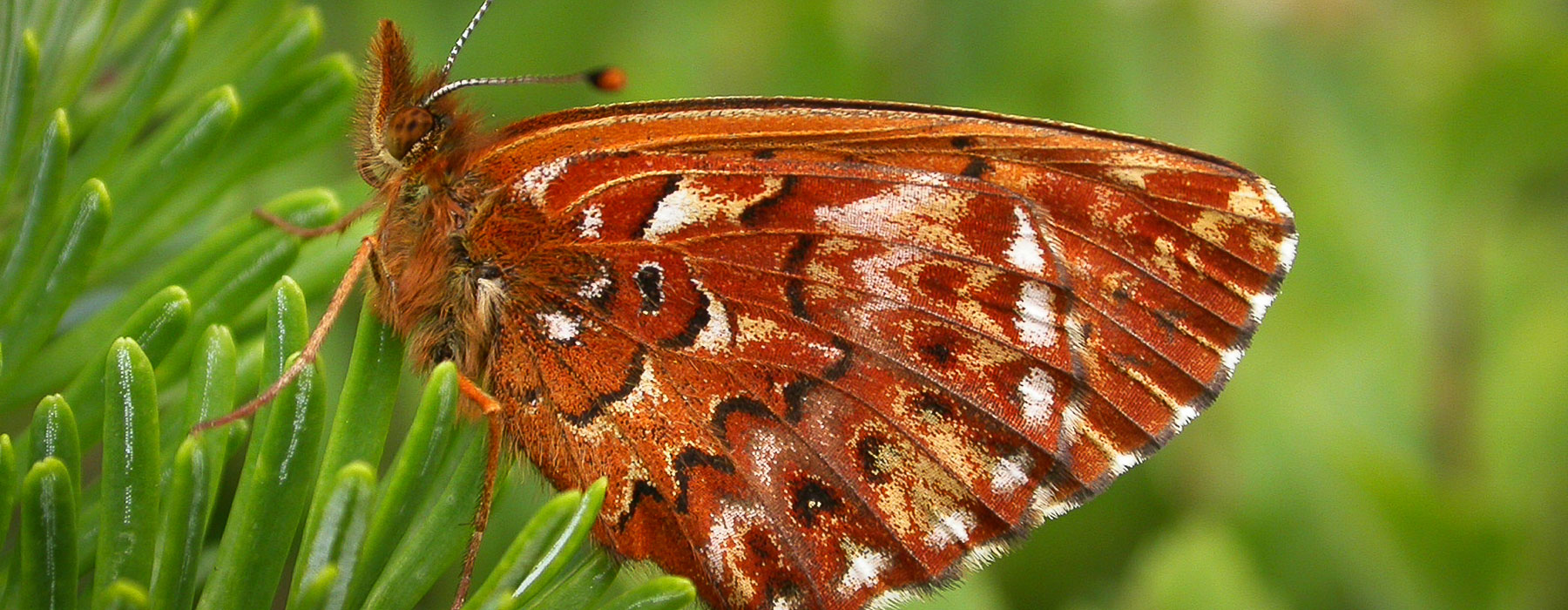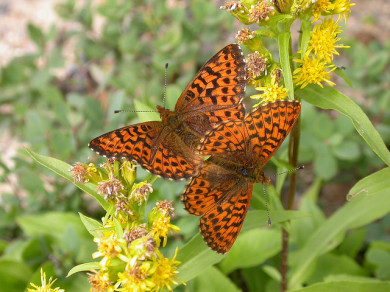Numbering in just the hundreds of individuals, White Mountain Fritillary are found only in a narrow elevational zone in the Presidential Range in the White Mountains of New Hampshire. It is hard to imagine butterflies with wing spans of less than one-and-a-half inches surviving the fierce weather of Mount Washington, but these are especially adapted.
Most butterflies complete their life cycle in less than one year. Because alpine summers are short, it takes two years for them to become adults. Because of their prolonged life cycle, these have some of the longest life spans known for butterflies. VCE's work with alpine butterflies have been instrumental in creating conservation awareness for this species. These unique butterflies are now formally recognized as “sensitive species” by the White Mountain National Forest. And, the New Hampshire Fish and Game Department listed them as endangered in 2008.
White Mountain Fritillary News
 June 01, 2017
June 01, 2017
New Paper Published: Density and Habitat Relationships of the Endemic White Mountain Fritillary (Boloria chariclea montinus) (Lepidoptera: Nymphalidae)
Abstract- We conducted point counts in the alpine zone of the Presidential Range of the White Mountains, New Hampshire, USA, to estimate the distribution and density of the rare endemic White Mountain Fritillary (Boloria chariclea montinus). Incidence of occurrence and density of the endemic White Mountain Fritillary during surveys in 2012 and 2013 were greatest in the herbaceous-snowbank plant community. Densities at points in the heath-shrub-rush plant community were lower, but because this plant community is more widespread in the alpine zone, it likely supports the bulk of adult fritillaries. White Mountain Fritillary used cushion-tussock, the other alpine plant community suspected of providing habitat, only sparingly. Detectability of White Mountain Fritillaries varied as a consequence of weather conditions during the survey and among observers, suggesting that raw counts yield biased estimates of density and abundance. Point counts, commonly used to study and monitor populations of birds, were an effective means of sampling White Mountain Fritillary in the alpine environment where patches of habitat are small, irregularly shaped, and widely spaced, rendering line-transect methods inefficient and difficult to implement. more » August 01, 2014
August 01, 2014
AMC Outdoors: Butterflies on High
As you pause near Cragway Spring along the Mount Washington Auto Road on a sunny day, your gaze might land on a small moth-like insect drawing nectar from a goldenrod bloom. more »Natural History
White Mountain Fritillaries fly from late-July until frost in September, mating and nectaring on alpine goldenrod and asters. Caterpillars hatch and begin to mature during the first summer. In their second summer, the caterpillars continue to grow, pupate, and metamorphose into adults (eclose) to start the cycle over again. What plant they feed on as caterpillars is still a mystery, despite more than 100 years of study beginning with the grandfather of New England lepidopterists, Samuel Scudder.
Adults fly from mid-July to mid September (confirmed dates: 12 July – 15 September). Males patrol for females during warm hours, while females rest or bask in the vegetation. Females fly close to the ground and walk or test by drumming potential host plants with abdomen. Adults observed nectaring predominantly Alpine Goldenrod (Solidago cutleri), but also Purple-stemmed Aster (Aster puniceus) and Meadowsweet (Spiraea latifolia).
Pair observed copulating while perched on Alpine Goldenrod on 15 August. Another male was present, but flushed upon approach. Females found with well developed eggs on 2 August and as late as 15 September (Scudder 1889). Eggs laid singly on underside of leaves in midsummer and the newly hatched first-instar larvae hibernate before completing development during the following summer. It is unknown if the first instar larvae feed in the wild, but they will feed in the laboratory.
Larvae from other populations are polyphagous, feeding on four chemically distinct plant families: Polygonaceae, Salicaceae, Ericaceae, Violaceae. Caterpillar host plants in eastern Canada are Dwarf Willows (Salix arctica and S. herbacea), Alpine Smartweed (Polygonum viviparum), Violets (Viola sp.) and Low Sweet Blueberry (Vaccinium angustifolium). In the lab individuals from the northern Cascades of Washington readily fed on Polygonum (preference for ovipositing), Salix and Viola, while Vaccinium was refused (K. Wolfe, pers. comm.). In Asia B. titania is known to feed on plants in the families Rosaceae and Ranunculaceae (K. Wolfe, pers. comm.).
There are no specific reports of host plants for B. t. montinus. However, possible host plants that grow in the alpine zone in Presidential Range are: willows (Salix herbacea, S. uva-ursi, S. argyrocarpa, S. planifolia), Alpine Smartweed or Bistort, Alpine Marsh Violet (Viola palustris) and V. adunca, Alpine Bilberry (Vaccinium uliginosum), Dwarf Bilberry (V. caespitosum), Velvet Leaf Bilberry (V. myrtilloides), Low Sweet Blueberry, Mountain Cranberry (V. vitis-idaea), and Small Cranberry (V. oxycoccos). Scudder (1889) reported that they often are seen around Dwarf Willow (Salix herbacea), but that despite searching no eggs were found. On one occasion he observed a female on Mountain Avens (Geum peckii) and was sure she laid eggs, but upon examination he found no eggs. He felt that Violaceae was a more likely host. A female (which later dissection showed to have ripe eggs) was kept for several days on a live violet plant on the summit, at treeline and at the base of Mt. Washington and never laid any eggs. Scudder tried this with several other individuals to no avail.
In other regions, larvae eat leaves of host plants and have no nest (Scott 1986). Larvae likely pupate in the leaf litter (Seidl 2002). In Colorado, adults eclose after larvae complete five instars, with males earlier than females (Seidl 2002).
Habitat and Distribution
Its entire range is limited to the alpine zone in the Presidential Range in the White Mountains, New Hampshire above approximately 1,220m elevation in wet alpine meadows, wet springs around rock outcroppings, alpine streamside communities and snowbank communities. Popular areas to find the butterfly are Cragway Spring area on the Mt. Washington Auto Road and the Alpine Garden.
Historic data were gathered from published and unpublished sources. Specimens have been collected throughout the Presidential Range – from Mt. Pierce at the southern end of the Presidential Range to Mt. Madison at the northern terminus. Historic data with indicated elevations range from 1,220 – 1,645 meters.
Population Status and Viability
The New Hampshire Natural Heritage global ranking is G5T2 – species is globally secure, but subspecies population imperiled because of rarity (generally 6 to 20 occurrences) or other factors demonstrably make it very vulnerable to extinction. Statewide ranking is S2 – state population imperiled because of rarity (generally 6 to 20 occurrences) or other factors demonstrably make it very vulnerable to extinction.
Scudder (1889) offers the earliest comments on the population status that remain true to this day.
“Probably no wandering collector has often seen more than eight or ten of these butterflies in a day’s scramble among the mountains, but if sought early in July they might be found in greater abundance; on a single occasion only I have seen as many as four at one time; they are most common about the steep heads of the great ravines…” He also wrote, “The butterflies, never very abundant…” and, “…as it would seem as if some special device were needed to maintain this apparently nearly extinct species in such a desolate region.”
Later, Scudder (1897) wrote, “The [Boloria] indeed seems really doomed to destruction. In the scanty numbers that one may find upon the mountain slopes, one sees the sign of their early departure; for, in the many years that I have searched for them with special pains, I have never seen more that a dozen or two specimens in a single day.”
Potential threats today include: global climate change, atmospheric pollution, increased UV-B light, recreation and development, and collecting.
Publications
- McFarland K.P., J.D. Lloyd, and S.P. Hardy. 2017. Density and Habitat Relationships of the Endemic White Mountain Fritillary (Boloria chariclea montinus) (Lepidoptera: Nymphalidae). Insects 8(2): 57. doi:10.3390/insects8020057
- McFarland, K.P. 2002. Conservation Assessment of Two Endemic Butterflies (White Mountain Butterfly, Oeneis melissa semidea and White Mountain Fritillary, Boloria chariclea montinus) in the Presidential Range Alpine Zone, White Mountains, New Hampshire. (PDF)



